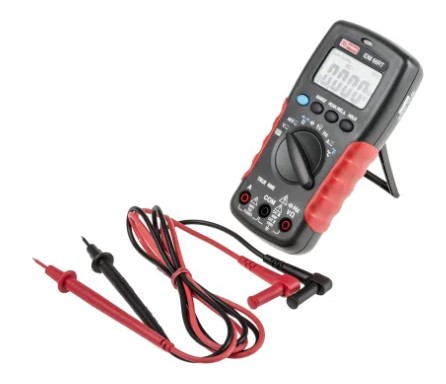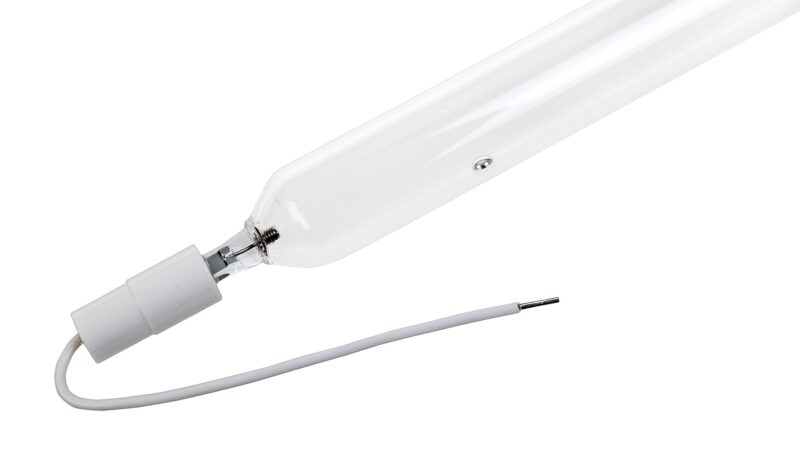Understanding the voltage of your UV lamp is critical to ensuring its proper replacement and optimal performance in curing, bonding, or coating systems. For UV lamps to function correctly, especially when seeking a replacement, you need to know the full operating voltage. This ensures that the new lamp matches the specifications of your system, removing the chance of a total failure to work, and ensuring the lamp operates efficiently with a long lifespan.
In this blog, we’ll guide you through the key steps to measuring a UV lamp’s voltage and provide some helpful tips to ensure accuracy.
Why Voltage Matters for UV Lamp Replacements
The voltage specification of a UV lamp is essential because it determines how the lamp performs under full power within your system. To design a suitable replacement, Alpha-Cure needs to know the lamp’s voltage at full power, along with either the lamp’s power (Watts), which can typically be found in the system specifications, or the lamps current (Amps), which needs to be measured using a meter, just like the voltage. Without these measurements, there’s a risk that the replacement lamp won’t meet the precise specifications required for your system, which can lead to inefficiency, operational issues, or even damage to the lamp or system components.
Measuring UV Lamp Voltage: What You Need
 Before getting started, you’ll need a way to measure the voltage. This will either already be built into your systems display functions or you will need a separate voltmeter or multimeter. We recommend that any external device is capable of measuring at least 1,000 volts, but please note that some systems may use even higher voltage lamps, so do check that your meter can handle the appropriate range. If you don’t have a meter available, they can easily be purchased online.
Before getting started, you’ll need a way to measure the voltage. This will either already be built into your systems display functions or you will need a separate voltmeter or multimeter. We recommend that any external device is capable of measuring at least 1,000 volts, but please note that some systems may use even higher voltage lamps, so do check that your meter can handle the appropriate range. If you don’t have a meter available, they can easily be purchased online.
When measuring voltage, make sure you’re reading the lamp’s voltage while it’s running at full power, not during warm-up, as the voltage can vary significantly in this stage.
How to Measure a UV Lamp’s Voltage
Here are four potential methods to obtain your lamp’s voltage reading. Please ensure that whatever method you choose, it is carried out by a fully trained electrician:
Step 1: Check System Monitoring Data
The easiest way to get an accurate voltage measurement is if your system provides built-in monitoring capabilities. Many systems display voltage data on a screen or provide a readout via connected software. If your system offers this feature, simply retrieve the voltage reading while the lamp is running at full power.
 Step 2: Use a Voltmeter or Multimeter
Step 2: Use a Voltmeter or Multimeter
If your system doesn’t provide voltage data, the next option is to connect a voltmeter or multimeter directly to the lamp’s power connections. To do this, you’ll need access to the lamp while it’s operational. This method involves attaching the meter to the end of the lamp connections and recording the voltage while the lamp is running at full power.
Step 3: Measure at the Power Connection Cables
If it’s not possible to access the lamp terminals directly, you may be able to access another place in the system where the lamp leads are connected, such as the terminals of a choke or transformer. Connecting the meter at these points will measure the lamp voltage.
Step 4: Send the Lamp to Alpha-Cure for Testing
If none of the above methods are possible, the final step is to send the lamp to Alpha-Cure. Our technical team can perform complete lamp testing and provide you with the correct specification. This is particularly useful for systems where lamp terminals are inaccessible or when precise voltage measurement tools aren’t available on-site.
Handy Hint: Estimating UV Lamp Voltage
As a general rule, the voltage of a UV lamp is never more than three times the total arc length in millimetres. For example, a lamp with a 250mm arc length would typically have a voltage of no more than 750 volts. However, this is only an estimate and lamps will often run on lower voltages, so we strongly recommend using a meter to obtain an accurate reading. Estimating a voltage should only be used as a quick check point in the specification process.
Alpha-Cure’s Lamp Specification Form
Once you have your voltage and either the watts or amps measurement, be sure to fill out Alpha-Cure’s Lamp Specification Form. This form includes all the necessary fields to help us design and quote for a replacement lamp that perfectly matches your system’s requirements. You can download the form here: Alpha-Cure Lamp Request Form.
Latest Articles
Alpha-Cure Is Attending LabelExpo Southeast Asia – Meet Us
Alpha-Cure’s Commercial Director, Berenika Bond, will be attending LabelExpo Southeast Asia in Ban...
View ArticleNew Interactive UV Lamp Troubleshooting Tool Launched
Diagnose and Resolve Common Issues with Confidence Alpha-Cure has launched a brand-new interactive U...
View ArticleThe Benefits of Infrared Lamps and Where to Use Them
It’s been a while since we featured Infrared (IR) Lamps in our blog series, despite them being...
View ArticleOptimising UV Curing Processes in the Printing Industry: Techniques and Benefits
As we push into a new year, now a great time to review your current print curing system set ups and ...
View Article